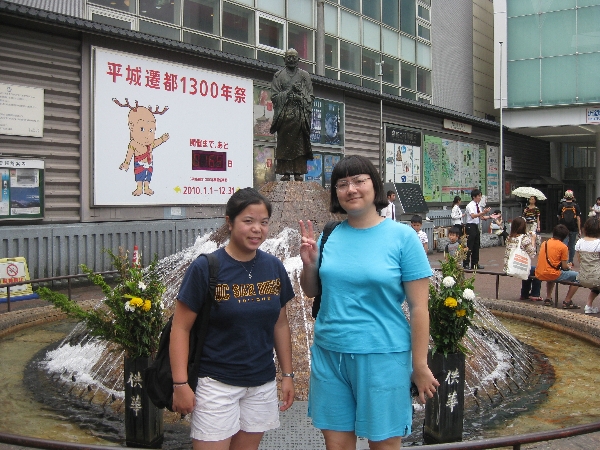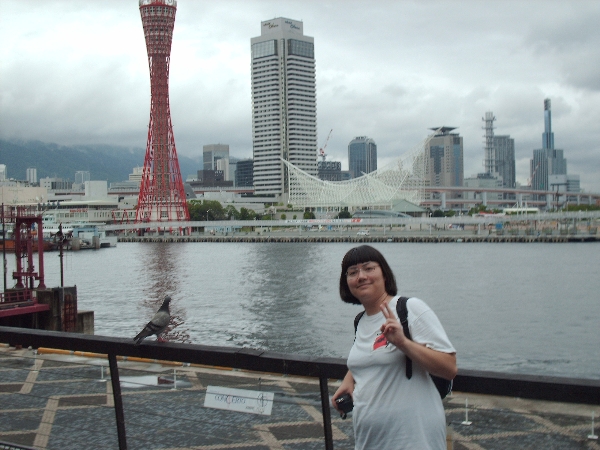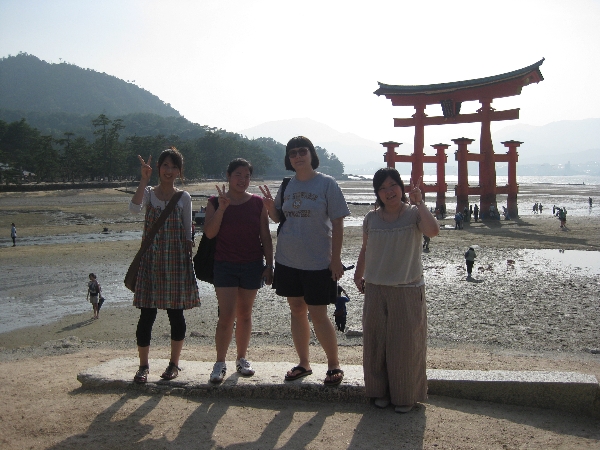
Me at Nara Park

Me at Nara Park
The first week of the program was spent in the Kansai area of Japan, which comprises Kyoto, Osaka, Kobe, and other neighboring cities. During this time, we stayed at one of Ashinaga's student dorms, the Rainbow House in Kobe. After spending three days sightseeing in Kyoto, Nara, and Kobe, we took the shinkansen (Japanese bullet train) to Hiroshima and spent a day and two nights sightseeing and staying at a Japanese-style inn there.

Stephanie and I in front of the Kobe Rainbow House
The Kobe Rainbow House was originally built by Ashinaga to provide housing for students who had suffered in the devastating Kobe earthquake of 1994. Nowadays the Rainbow House, along with the Ashinaga Heart School dorm in Tokyo, provides affordable housing for college students receiving Ashinaga scholarships. The Kobe dorm is a lot smaller than the one in Tokyo, with only about 30 students living there when I went. Stephanie and I stayed at a room in this dorm for about 5 days while we did sightseeing in Kansai.
View outside the Rainbow House: The view outside our 4th floor room. Not the most beautiful scenery in Japan but I got used to it. We awoke to the sound of cicadas outside our window every morning.
Down the street: The view going down the street from the Rainbow House. Lots of little restaurants, homes, and convenient stores along the way. At the end, there's a mall with a supermarket, arcade, and other areas. Further down is the train station.
Bedroom: Here's the bedroom that Stephanie and I stayed in. It was a four-person room but we had it all to ourselves. It was just beds, desks, and closets though; the kitchen, shower/bath, laundry room, and toilets were in other rooms on that floor and were shared by all the girls.
Library: The library room at the Rainbow House has computers, printers, desks, and books for studying and reading. I spent a lot of time here e-mailing my mom back home. You can see my black laptop in the photo there.
Bathing room: Unlike America, people of the same gender bathing together in one big bath room is pretty common in Japan. This is the communal bathtub at the Rainbow House, with the sit-down showers off to the left there. There were a couple standing-up showers in the room too (though they didn't have any doors).
Neighborhood: And here's one more photo of the area outside the Rainbow House. Again, not the prettiest neighborhood but it was very peaceful.

Our group in front of Yasaka Shrine
Kyoto was the first place we went sightseeing. Since I already spent a good amount of time there during my last Japan trip, I didn't take a ton of photos, but it was still fun and nostalgic nonetheless ^^ You can see more Kyoto and Nara coverage on my previous Japan trip page here.
Higashi Honganji front: Higashi Honganji is a popular Buddhist temple in Kyoto. This is the front, with its pretty lily pads. You can see Kyoto Tower in the background.
Feeding the pigeons: Higashi Honganji is also famous for its extremely friendly pigeons. You can get seeds at the front entrance to feed them and they're perfectly content to perch on your hands, arms, shoulders, back or anywhere. Here I am feeding them in this photo. Their claws are a little prickly but it's worth it ^^
Higashi Honganji: Our group in front of the Higashi Honganji temple. There was some construction at the temple when we went but we were still able to go inside.
Yasaka Shrine front: The front entrance of Yasaka Shrine, one of Kyoto's most popular tourist areas. It's pretty hard to miss with its bright orange colors =)
Yasaka Shrine pond: There's a beautiful pond at Yasaka Shrine with a lot of turtles, ducks, koi fish, and pigeons. We had fun feeding them (and watching them compete for food XD)
Kiyomizu Temple: Stephanie and I at Kiyomizu Temple, one of Kyoto's other popular tourist attraction. Unfortunately it started to rain heavily when we arrived so we had to wait for it to lighten up before we could walk around. I didn't take too many photos because of the weather but you can see more on my previous Japan trip page. When the weather is nice, the scenery there is breathtaking.
Kamogawa River: The famous river that flows through Kyoto. We rested here for a while during our sightseeing.

Stephanie and I in front of Nara station
Second on our sightseeing tour was Nara, the one other place in the program itinerary besides Kyoto I had been to before during my last trip. Nara is another popular visiting place, particularly the park with all the tame deer walking around, and Toudaiji temple with its giant Buddha statue.
Origami Pegasus: On our way to Nara Park, we took a detour to this little temple that had a ton of gorgeous origami works on display. I especially liked these origami Pegasus.
Origami cards: More origami, particularly greeting cards.
Deer Park: The 100+ tame deer that walk around Nara Park will let you pet them and mingle with them. They'll definitely come over to you if you purchase food for them from a stand like the one on the right in the photo.
Kofukuji: Our group in front of the big pagoda, Kofukuji, at Nara Park.
Todaiji temple: Todaiji is the largest wooden structure in the world with the world's largest Buddha statue inside. There's me in front of it.
Buddha: The large Buddha statue in Todaiji.

Me at Kobe Port with Port Tower in the background
For our third and last sightseeing day in Kansai, we went to places in Kobe, the city where the Rainbow House is located. First, we went to an aquarium in Suma. I don't really approve of aquariums and zoos because I know about the terrible things they do to catch the animals they display and I'm sure a lot of them are worse off there. But I was curious what a Japanese aquarium was like, and since the aquarium was free during that time because of the recent swine flu outbreak in Kobe (they wanted to get tourists to come back), we decided to go. As far as aquariums go, it was pretty nice I guess, and the animals seemed well taken care of. After that, at Kobe Port, we went to the top of Port Tower and saw the memorial of the Kobe earthquake.
Suma Aquarium tank: Pretty coral in one of the tanks.
Suma Aquarium big tank: The first big tank at the aquarium. They really had an amazing variety of sea life there; sharks, rays, crabs, octopuses, eels, and all kinds of fish. Since the Japanese eat so much sea food, it makes we wonder how much compassion they feel for the creatures they see here ~_^
Dolphin show: At the dolphin show, the dolphins did tricks and the trainers explained how they trained them.
Sea otter feeding: We got to see both the sea otter and seal feedings while we were there. It was so cute how the sea otters would take the food from the keeper and eat it while floating on their backs.
Kobe earthquake memorial: After the aquarium, we visited the Kobe earthquake memorial at Kobe Port. In addition to some displays and a video screen, the memorial also had this small area left untouched since the earthquake, as you can see from the tilting street lamp and broken concrete.
Port Tower view: Here's a view from the top of Port Tower. You can see just about all of Kobe.
Ghibli store: I was surprised to find a Ghibli store in the mall area of Kobe Port. There's me and Totoro ^_^

Our group at Miyajima island in Hiroshima
We took the shinkansen (Japanese bullet train) from Kansai to Hiroshima and stayed there for one full day and two nights. Our inn was totally Japanese-style, complete with tatami room, futons, sliding paper doors, and no chairs XD During our stay in Hiroshima, we went to the Atomic Bomb Dome Museum followed by a ferry ride to Miyajima, an island in Hiroshima with shrines, souvenir shops, and more deer, though they're not as friendly as the ones in Nara.
Tanada inn: Here's the tatami and futons we slept inn at the Tanada inn where we stayed. It was a pretty nice inn except for the noisy traffic outside and the extremely narrow toilet room =P
Breakfast: My favorite part of staying at the inn was the lavish breakfasts they served us during our two mornings there.
Atomic Bomb Dome Museum: The park area outside the Atomic Bomb Dome Museum. The structure in the back was left untouched after the bombing. All in all, going to that museum was very moving yet also disturbing and saddening. But thankfully it offers a sense of hopefulness too.
Paper Cranes: In Japan, it's said that if you fold 1,000 origami paper cranes, your wish will come true. There's a famous story about a girl named Sadako who got sick and died as a result of radiation exposure from the bombing and was unable to finish folding all her cranes. You can find thousands of paper cranes all over the Atomic Bomb Dome as a dedication to her and the others who died.
Atomic bomb artifacts: There were tons of things to see at the museum; artifacts, video screens, photographs, dioramas, informational displays, etc,. Unfortunately I don't have room to post everything, but here's an example of the kinds of artifacts on display. This is a tricycle and a helmet after they were exposed to the bomb's radiation.
Miyajima beach: To get to Miyajima island, you can take the JR ferry. When the tide is out during the day, people can walk along the beach and tide pools. There were tons of hermit crabs and little fish in the pools. When the tide comes in at night, the legs of the torii gate get submerged.
Miyajima shrines: When you're finished with the beach, you can walk through the big shrine area here. After that, there are shops and a few more shrines along the way.